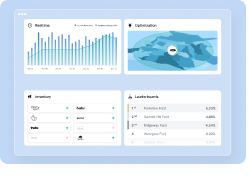The one number that shows if your dealership is beating the competition.
Dealership growth means little in isolation. To know if you’re truly advancing, you have to measure it against your competitors and OEM. That’s what market share tells you.

June 12
Share this blog:
With more data and insights available than ever, it’s easy for dealerships to get caught up in the excitement of high store visits, a spike in website traffic, or even increased sales. But before you start celebrating that “record-breaking” month, ask yourself: did your competitors experience the same boost? A high volume of car sales might simply be a market-wide trend rather than a unique win for your dealership.
Your dealership might have enjoyed an influx of store visits last month. However, if every other dealership in your market saw similar numbers, did you really gain ground, or were you just benefitting from a market-wide upswing? The same goes for any other figure. A dip in sales might seem concerning at first glance, but if your competitors experienced an even steeper drop, you could actually be in a stronger position than you think.
While an increase in sales and website visits can signal market share growth, raw metrics like sales, walk-ins, or traffic can be deceiving. They provide a snapshot of activity, but they don’t tell you where you stand relative to the competition. It’s all too easy to mistake a market-wide trend for your own success—or failure.
Raw metrics alone paint an incomplete picture. If sales rise but competitors’ sales rise more, you’re losing ground—even if it doesn’t feel that way. And while fewer sales but a larger share of the market might feel like a loss, it’s actually a competitive gain. Yes, less revenue can be discouraging, but if you’re capturing more of a shrinking market, you’re outperforming others in the same environment. That’s a sign of strength.
Market-wide demand shifts are beyond your control. What is in your control is how well you compete within that demand.
Before you celebrate or worry, take a step back. Look at how you’re performing relative to your local market and your brand. Real growth comes from outpacing competitors, not just following the broader trend.
Join the EMG mailing list.
Stay connected with EMG and get the latest posts delivered straight to your inbox.
EMG will handle your data pursuant to its Privacy Policy.
Ready to get started?
Learn how EMG drives measurable market share growth for dealerships.
Recent blogs.
View all blogsCopyright © 2025. All Right Reserved




